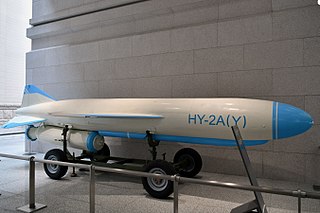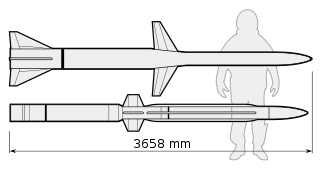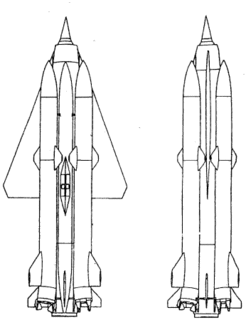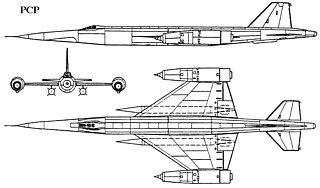
The Avro Blue Steel was a British air-launched, rocket-propelled nuclear armed standoff missile, built to arm the V bomber force. It allowed the bomber to launch the missile against its target while still outside the range of surface-to-air missiles (SAMs). The missile proceeded to the target at speeds up to Mach 3, and would trigger within 100 m of the pre-defined target point.

A ramjet, or athodyd, is a form of airbreathing jet engine that uses the forward motion of the engine to produce thrust. Since it produces no thrust when stationary ramjet-powered vehicles require an assisted take-off like a rocket assist to accelerate it to a speed where it begins to produce thrust. Ramjets work most efficiently at supersonic speeds around Mach 3 and can operate up to speeds of Mach 6.

The Shang You or SY-series, and the Hai Ying or HY-series were early Chinese anti-ship cruise missiles. They were derived from the Soviet P-15 Termit missile.

The Lockheed X-7 was an American unmanned test bed of the 1950s for ramjet engines and missile guidance technology. It was the basis for the later Lockheed AQM-60 Kingfisher, a system used to test American air defenses against nuclear missile attack.

The Republic XF-103 was an American project to develop a powerful missile-armed interceptor aircraft capable of destroying Soviet bombers while flying at speeds as high as Mach 3. Despite a prolonged development, it never progressed past the mockup stage.

The Bell X-9 Shrike was a prototype surface-to-air, liquid-fueled guided missile designed by Bell Aircraft as a testbed for the nuclear-armed GAM-63 RASCAL. It is named after the shrike, a family of birds.

The North American SM-64 Navaho was a supersonic intercontinental cruise missile project built by North American Aviation (NAA). The final design was capable of delivering a nuclear weapon to the USSR from bases within the US, while cruising at Mach 3 at 60,000 feet (18,000 m) altitude. The missile is named after the Navajo Nation.

The AIM-152 AAAM was a long-range air-to-air missile developed by the United States. The program went through a protracted development stage but was never adopted by the United States Navy, due to the ending of the Cold War and the reduction in threat of its perceived primary target, Soviet supersonic bombers. Development was cancelled in 1992.

The Burya was a supersonic, intercontinental cruise missile, developed by the Lavochkin design bureau under designation La-350 from 1954 until the program cancellation in February 1960. The request for proposal issued by the Soviet government in 1954, called for a cruise missile capable of delivering a nuclear payload to the United States. Analogous developments in the United States were the SM-62 Snark and SM-64 Navaho cruise missiles, particularly the latter, which used parallel technology and had similar performance goals.

The Buran cruise missile, designation RSS-40, was a Soviet intercontinental cruise missile by Myasishchev capable of carrying a 3,500 kg hydrogen bomb payload. The project was canceled before flight tests began. It is unrelated to the later Buran reusable orbiter.

The Tsybin RSR was a Soviet design for an advanced, long-range, Mach 3 strategic reconnaissance aircraft.

The AQM-60 Kingfisher, originally designated XQ-5, was a target drone version of the USAF's X-7 ramjet test aircraft built by the Lockheed Corporation. The aircraft was designed by Kelly Johnson, who later created the Lockheed A-12 and its relatives, such as the Lockheed SR-71 Blackbird and Lockheed YF-12.

The C-301 is a large supersonic coastal defense anti-ship missile (AShM), and it is the basis on which two other members of the C-300 series AShM C-302 and C-303 developed from.

The Tupolev Tu-2000 was a planned hypersonic flight experimental aircraft designed by the Tupolev design bureau. It was intended to test technologies for a single-stage-to-orbit aerospaceplane and also the Tupolev Tu-360 intercontinental bomber.
The Keldysh bomber was a Soviet design for a rocket-powered sub-orbital bomber spaceplane, which drew heavily upon work carried out by Eugen Sänger and Irene Bredt for the German Silbervogel project.

The MQM-42 was a supersonic target drone developed by North American Aviation. Developed in two subvariants, Redhead and Roadrunner, it was used by the United States Army in the 1960s and 1970s.
The Nord CT.41 Narwhal was a French target drone, designed and built by Nord Aviation during the late 1950s for the purpose of providing training in the interception of supersonic bomber aircraft.
The BUAA UAV are Chinese UAVs developed by Beihang University (BUAA), which are intended for various missions such as experimental research, reconnaissance missions, and some have since entered service with Chinese military and governmental establishments.
The Wright XRJ47 was an American ramjet engine developed in the 1950s to help propel the rocket-launched SM-64 Navaho supersonic intercontinental cruise missile. Although the design flight Mach Number was 2.75, a peak flight speed of Mach 3.0, at altitudes up to about 77000 ft, was envisaged. This very large ramjet had a number of design problems, including some difficulty in light-up. Development of the Navaho missile was cancelled along with the ramjet engine in 1957.
Çakır is a new generation cruise missile that can be launched from land, sea and air platforms with a range of more than 150 km (93 mi), designed by Turkish rocket and missile manufacturer Roketsan. It was introduced with the launch of Roketsan Ankara Lalahan facilities on 31 March 2022. On the same day, a video about the missile was shared on the Twitter account of Roketsan.














